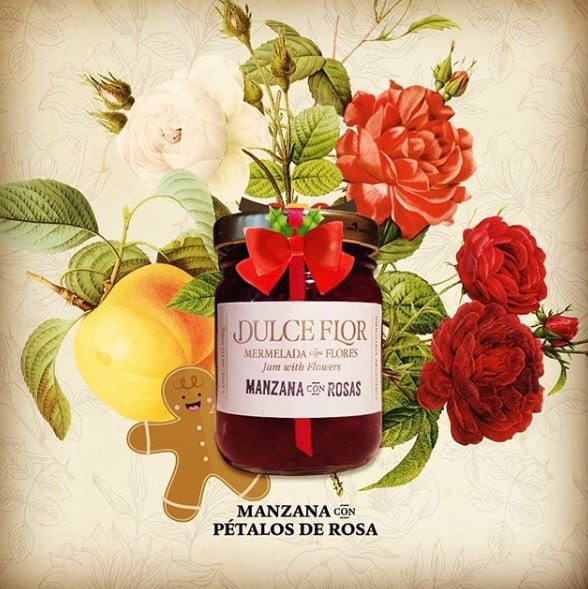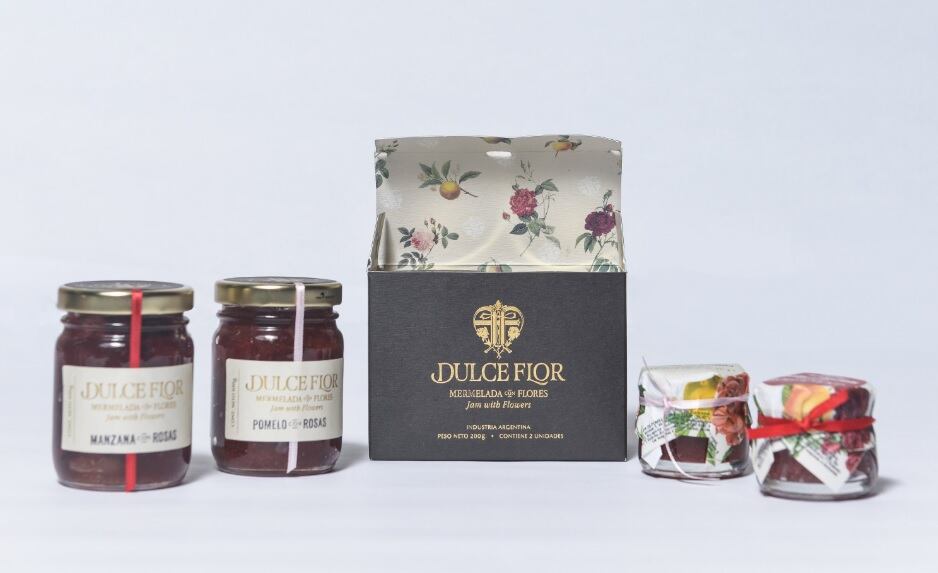The company started life in 2010 in the sunny province of Mendoza, Argentina. The place held a special place in the heart of Fernanda Piffaretti, Dulce Flor’s founder, where she was inspired to develop products capable of preserving the evocative flavors and aromas of flowers, with fruit. And some years later, together with her husband, she started this undertaking.
“The stories and flavors that I shared with my grandmother Elena around the rose petals she generously gave me to try on certain occasions, were my inspiration,” she told us, evoking those childhood memories.
“Additionally, I was inspired by a certain place in her kitchen: a cupboard full of delicious jams, where I liked to spend long hours enjoying the aromas, colors and unique flavors. Somewhere in my head these two memories merged, and they became the perfect combination to carry out this project, which is a tribute to my family and my beautiful grandmother,” said Fernanda, remembering those extremely seductive ingredients that finally paid off.
But it was not until 2013, after she was trained in organic crops and handicraft manufacturing, that the venture started, and years later, in 2016, it went on to a commercial scale.
Distribution and availability
Nowadays they sell through premium product resellers, where the client, guided by an expert seller, finds and buys these unusual products.
They also often attend fairs and other gastronomic events, focusing specifically on the gourmet pastry activity and selling to the gastronomic elaboration sector.
“We plan to continue expanding the range of products in the line of jams, always adding organic natural flowers, which not only provide aesthetic and poetic value, but flavor, aroma and nutritional quality,” said the company.
Since sales are growing year after year, the owners are optimistic about Dulce Flor`s future. And although they do not export yet, Dulce Flor is working hard to reach the international market in a short time, showing special interest, in a first stage, in the Latin American market.
The products

Dulce Flor offers a range of jams with unique combinations of flavors, such as Grapefruit with rose petals (“intense and delicate”); Apple with rose petals (“sweet and fresh”); Strawberry with rose petals (“classic and harmonious”); Tangerine with saffron petals (“sophisticated and elegant”) and their latest creation, made with pear and jasmine petals, which suggests a “fresh and delicate experience”.
All of them include the essential business values preached by Fernanda and her husband. “Our mission is to generate innovative, distinguished and exclusive products, maintaining a healthy diet and taking care of the environment,” they said.
But being passionate about gastronomy, she has also some great recommendations about how to combine every flavor.
“Strawberry jam with rose petals is ideal to enjoy with cheeses, sparkling wines, and desserts with chocolate and pecan nut; while blue cheeses, white wines and ginger and pistachio desserts should be combined with the pear and jasmine marmalade,” explained Fernanda.
“However, young palates request flavors like apple and strawberry with rose petals, while more complex palates enjoy grapefruit with rose petals and mandarin with saffron petals, depending on how the consumer wants to mix it,” she added. This explains why they do not have a star product.
Flowers as a functional food
Since ancient times edible flowers have been used in food, but in the 80s certain chefs started using them to give their dishes a touch of distinction and, fundamentally, to enhance the flavor of the main ingredients and enrich their nutritional properties. This is how flowers gained further value among the consumers.
US, China and Mexico are some of the countries pioneering this new use of flowers that, provided they are edible species grown organically, are known to bring health benefits. Edible flowers are rich in vitamins (A, B, C, D, K, PP, and B12) as well as minerals, proteins or amino acids.
There are about 250 edible flower species. In the kitchen the most popular ones are violets, rose petals, pumpkin flower, marigolds, chrysanthemums, jasmine, carnations, orange blossoms, mallows, pansies, gladioli and poppies. Nutrition experts affirm that the opportunity and innovation of incorporating flowers to a meal will be given by the functional and healthy properties that can be extracted from their petals. The daily incorporation of them into a diet plays an increasingly important role to prevent diseases related to oxidative stress, through the supply of vitamins E and C, and bioactive compounds of vegetable origin. One simple example: the value for total polyphenols reaches more than 150 times higher than fruits such as blackberries and blueberries, plums, strawberries and grapefruits, and vegetables like broccoli, cabbage and spinach.

